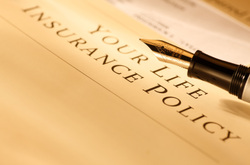Often times we find that home owners who take out a mortgage on their homes end up buying mortgage insurance as well. What Mortgage insurance essentially does is insure your outstanding home loan with the bank as the beneficiary and in the event of your death squares off your mortgage loan by paying the bank whatever is outstanding on your loan. For many people it’s a matter of priority to ensure that their loved ones would not be burdened by their debts when they are gone. But choosing the right insurance vehicle is equally important for both the insured and their beneficiaries. Adam Ginsberg, the pioneer in eBay entrepreneurship and now a leading coach and mentor on online business and wealth building shares his views on whether or not is it a good idea to take out mortgage insurance. As mentioned above, mortgage insurance comes into play upon the passing away of the insured, absolving his or her next of kin from repaying the mortgage loan. However, there are a few things worth looking into before signing on that dotted line. More often than not, taking out mortgage insurance is not such a great idea. Here’s why. To begin with mortgage insurance is clearly not in your family’s favor as the insured amount will be paid directly to the loaning bank in the event of your death and your family will not see a dime of it. It is a good idea if you have taken out enough life insurance coverage to cover your family’s needs apart from the mortgage. For example, if you take out an additional term policy for the same amount of premium as you would have paid on the mortgage insurance then your family would’ve had the flexibility of taking care of more important expenses like other high interest loans than the mortgage and continue to make mortgage payments as before. Secondly, with mortgage insurance, the value of the policy decreases over time since it only covers the outstanding balance on your loan, whereas the premium remains the same throughout. On the other hand, a life insurance policy will pay your next of kin the same amount in the last year of its term as in the first. Adam Ginsberg suggests weighing all your options and arming yourself with as much information as possible ( read more here) before taking a mortgage insurance against your home loan. To know more about Adam Ginsberg and his great new eBay software and entrepreneurship tools go here.
 Whenever someone mentions, or even wonders aloud if they should take out insurance for their children, a hot debate kicks off. Every single time! This is probably one topic of personal finance/insurance that doesn’t seem to have unanimity on either side. Adam Ginsberg, the online entrepreneurship and wealth-building coach, too studied the various arguments and has decided to put forth his views on the subject. First and foremost, taking out insurance for children is a sensitive topic for parents as each parent thinks differently about the welfare of their children. Hence, the decision to buy or not to buy life insurance for children should be left entirely to the parents. But here are a few arguments, both for and against, that Adam Ginsberg believes should be shared with parents so as to help them take an informed, albeit an emotional decision. The one argument that leans heavily in favor of buying insurance for children is to allow them to enjoy insurance coverage later in their lives in case they end with a chronic illness or a disability which renders them uninsurable. If this is the argument that you as a parent are going to consider then Adam Ginsberg suggests buying a whole life insurance policy, which will keep your child insured for his or her entire life, and also give them some returns in terms of the cash value of the policy. If that is the way you are going to go as a parent, then experts advise buying a renewable term plan for a high value makes more sense, and that too which has the option of converting into a whole life policy later. On the other hand, the pundits believe that that purpose of insurance is to cover the loss of wage or income in the event of the insured person’s demise, and since children are not earning any livelihood, it is pointless to take out insurance policies for them. Instead, investing in a good 529 plan or IRA make better sense in the case of children. Click here to read more about what various experts think about this never ending argument. To know more about Adam Ginsberg’s views on personal finance and about his eBay tools and software, go here.
 As discussed in a previous post, life insurance is a complicated subject and there are no easy ways to know which one is right for you, how long you should take it for, how much insurance is enough etc. etc. No one can answer these questions for you—you’ll have to work them out yourself. But, what Adam Ginsberg can do to help you reach a decision about which type of insurance to buy is break down the two kinds of insurance available, i.e., term insurance and permanent, or whole life insurance. The most basic difference between a term policy and a whole life policy is that a term policy only provides death benefits to the insured person’s beneficiaries in the event of his or her death. A whole life policy, on the other hand, has an investment component along with death benefits which builds cash value over the life of the policy. Therefore, the returns on a whole life policy can be enjoyed by the insured person as well during his or her lifetime. Secondly, a term insurance policy is taken out for a fixed term, like 10, 15 or 20 years. On the other hand a whole life insurance policy lasts for as long as you keep paying your premiums. The third basic difference between the two policies is the applicable premium. Term insurance plans have very low premiums compared to whole life policies as a part of the premium for the latter is invested in building the cash value component as described earlier. Apart from these basic differences, what you should consider when choosing an insurance policy is the death benefit offered. On one hand you may be able to get a $500,000 term policy, for say, $300 annual premium, but for a whole life policy of the same amount may cost you $3000 every year. Therefore, before you make a decision, you should consider whether you are better off investing in a term policy for $300 and investing $2700 in other investment vehicles with higher returns or if you should hedge your risk and invest in a whole life policy for lower returns. For more tips from Adam Ginsberg on finance and how to make money online read the secrets of an auction millionaire.
Life Insurance is a simple and, at the same time, a complicated topic of personal finance. Simple because it serves a very simple purpose—to provide for your family and loved ones after you’re gone or even for yourself in case of loss of income etc. And, complicated because we can almost never figure out how to predict how much we’d need in the future to keep us protected from these anticipated losses. Adam Ginsberg, one of America’s leading internet entrepreneurship and wealth building coaches sheds some light on the various kinds of life insurance and how to choose the right one. Various kinds of life insurance Life insurance can be split into two broad categories, i.e., term insurance and whole life insurance. Term insurance basically guarantees a specific sum of money to be paid to the family of the insured person in the event of his or her death, or in some cases permanent disability as well. Term insurance policies are taken out for a specific period and a specific amount. If the insured person outlives the period of the policy, then the policy expires. In short, term policies are pure insurance in the event of a tragedy, and nothing more. Whole life insurance, on the other hand covers the insured person throughout his or her life span. These policies include a variable cash value that builds over time along with guaranteed death benefits. However, the premiums for these policies tend to be higher since a portion of the premium goes into making investments on your behalf for that cash value component. Choosing the right insurance Now this is the tricky part. There are as many points-of-view on how to choose the right insurance as there are people you know. However, each individual’s requirements are as unique as the individual themselves and only you can decide which insurance policies will suit you best. There many of your life’s factors to consider while making this decision and Adam Ginsberg suggests a basic approach to analyzing various factors before making a decision. Factor #1 – Your Age Age is perhaps the most crucial factor while deciding on your insurance policies. For instance, if you are young and single or older with grown up, independent children then you may not need pure life insurance at all. However, if you are married and have children with other liabilities like mortgage or auto loans, then you should have at least one term insurance policy. Factor # 2 – Policy Period If you have children, then the term period for a life insurance policy should be long enough to cover your children’s college-going age. For instance, if you have children aged 10 and 5, then you should take an insurance plan for a period of 15 years, which will cover your younger child till his or her college years. Factor # 3 – Insured Amount This again is a very crucial factor that tends to confuse people while choosing an insurance plan. According to Adam Ginsberg, the ideal insured amount should be the one that covers all your liabilities, like your mortgages and auto loans, and a few times your annual income to help your family tide over in the event of your death, and get back on their feet again. These are the three basic factors that influence your decision while considering taking out a term insurance on your life and should be analyzed meticulously to help you get the right decision. Keep a look out for more articles on insurance advice from Adam Ginsberg on this website. And, for any feedback that you may have on our articles, please feel free to write to us.
 My name is Adam Ginsberg and I’ve been helping millions of people just like you use eBay software programs such as eBay Listing Software to grow their home based business. Today, I’m going to give you a brief introduction to this software and tell you how to use it an optimum efficiency for maximum profit. I’ve been using eBay software for many years and have become known as one of the best eBay Sellers out there! eBay software programs such as the eBay Listing software program is an easy to use application that allows you to easily create listings of all the products you are selling on your auction site. It’s very simple. It can be used to sell one or multiple products at one time. There are many different types of eBay listing software programs available on the Internet today. It’s important that you do your research and pick out the program that is right for you. I use a variety of different programs based on my unique needs so you will definitely need to look around first. What kinds of products are you selling? How can they be listed in an easy-to-read format that your buyers will love (and buy!)? In a nutshell, the eBay listing program helps eBay sellers like yourself create lists of products on your eBay storefront. There are many different themes to choose from. Make sure your theme is consistent and fits in with your overall brand messaging. You can also use an HTML editor to customize your eBay listing program even more. The best part of this listing software is that it lets you create categories for your goods. You can also easily learn eBay functions like the ability to set and forget your eBay auctions. One of my favorite features is to list multiple auctions at one time. You will definitely start depending on your software. Overall, eBay software programs such as the eBay listing program is a great addition to your marketing toolbox. It will help you become a more efficient and profitable seller online. Should you have any questions relating to this post please feel free to contact me. Posted on behalf of Adam Ginsberg by the Adam Ginsberg Team
 Do you dream of owning your own business? Does the idea of setting your own hours make you weak in the knees? Becoming an eBay entrepreneur might be the perfect job for you. My name is Adam Ginsberg and I found my success by becoming an eBay PowerSeller. Many years ago, I was like you and I worked a regular nine-to-five job. I dreamed of starting my own business but worried about leaving the security of my regular job. Finally, I decided to make the jump to become an eBay entrepreneur and I haven’t looked back since. Here’s how I did it: Do Your Research eBay takes about 9% of every transaction you make online. There are other fees such as fees and shipping costs as well. Make sure you do your research when it comes to becoming an eBay entrepreneur. Visit the eBay site often and research other businesses like yours. How do they market their services and products? How can you set yourself apart from the completion? You have to differentiate yourself to become successful using eBay Make a Plan Before you create your eBay account, make a business plan. Successful entrepreneurs always have a plan of action. Put your research to work. Purchase the eBay software you need, take pictures of your products, and map out how you will sell them online. You should also create a budget and marketing plan. Take advantage of social media platforms such as Facebook, Twitter, Pinterest and LinkedIn to market your products and services. Re-Evaluate Your Progress Every Three Months You should re-evaluate your progress on eBay every three months. Set aside some time to see what works and what doesn’t. Are you selling as much as you thought you would? What marketing tactics have worked and what has tanked? How is your supply and demand? Do you need to hire additional help? These are some of the questions you should ask yourself every three months. Many people dream of owning their own business. Becoming an eBay entrepreneur is a great choice for many individuals. Make sure you do your research, make a plan and re-evaluate your progress every three months to ensure success. If you want help with your eBay selling plan, please feel free to contact me anytime. I look forward to hearing from you. Posted on behalf of Adam Ginsberg by the Adam Ginsberg Team Adam Ginsberg is helping people to become financially independent with his resources like eBay templates, eBay software and eBay tools. If you want to know more about his resources you can visit Secrets of an Auction Millionaire, Success with Adam or even Adam’s main website. You can also listen to some testimonials of his satisfied customers
|






 RSS Feed
RSS Feed